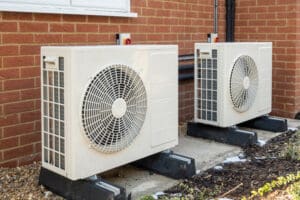
The journey toward decarbonizing buildings can seem complex, but it is powered by several core technologies that make it easier and more efficient to reduce emissions.
Understanding these technologies helps property leaders make informed decisions and implement the most effective solutions for their portfolios.
Heat Pumps: Efficient Heating and Cooling
Heat pumps are one of the most important technologies in the decarbonization toolkit. Unlike traditional gas or oil-based heating systems, heat pumps move heat rather than generating it, making them much more efficient. They can be used for both heating and cooling, reducing the need for separate systems. Air-source heat pumps, for instance, draw heat from the outside air even in cold weather, while ground-source heat pumps tap into the Earth’s stable underground temperatures.
By replacing gas boilers with heat pumps, property owners can significantly reduce their reliance on fossil fuels, cutting carbon emissions and energy costs simultaneously.
Renewable Energy Systems: On-Site Power Generation
Solar panels are the most commonly deployed renewable energy technology for buildings, especially in urban settings where roof space is readily available. Advances in photovoltaic (PV) technology have made solar panels more efficient and affordable than ever before. In some cases, properties may also benefit from wind turbines, geothermal systems, or even solar thermal systems for water heating.
For larger properties or portfolios, energy storage systems like batteries can be paired with renewable generation, allowing buildings to store excess power generated during peak production periods for later use.
Smart Building Automation: Optimizing Efficiency
Smart building technologies are essential for optimizing energy use and reducing waste. By integrating IoT devices into building management systems (BMS), property owners can automate and monitor everything from lighting and heating to security systems. These technologies allow for real-time adjustments based on occupancy, weather conditions, and energy prices, ensuring that no energy is wasted.
For example, smart thermostats can automatically adjust heating or cooling when tenants leave or enter a space, while smart lighting systems can dim or turn off lights when rooms are unoccupied. These small adjustments can lead to substantial energy savings over time.
Advanced Insulation Materials: Cutting Edge Efficiency
While insulation may not seem as exciting as high-tech gadgets, advancements in insulation materials have made it a critical component of decarbonization efforts. New materials like aerogels and vacuum-insulated panels offer dramatically improved thermal resistance with much thinner profiles, making them ideal for retrofits in older buildings where space is limited.
Properly insulating a building is one of the most cost-effective ways to reduce heating and cooling needs, contributing to lower energy use and emissions.
Actionable Tips
Property leaders should consider piloting new technologies in a few buildings before rolling them out across their portfolios. It’s also wise to work closely with technology providers to customize solutions based on the unique needs of each building. Regularly attending industry conferences or subscribing to technology-focused publications can help property owners stay informed on the latest innovations.
By leveraging these technologies, property managers can significantly reduce their buildings’ carbon footprints and enhance overall efficiency.
Read more:
The Essential Technologies Driving Building Decarbonization





